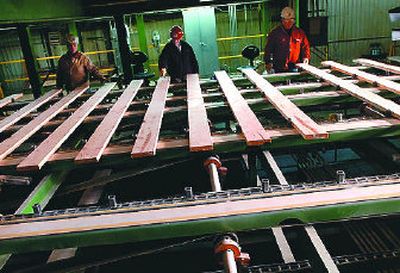Lumber market shaky

Inland Northwest sawmills are bracing for “very strong headwinds” in the 2007 lumber market, said Mike Covey, Potlatch Corp.’s chief executive officer.
After five years of record demand, North American sawmills are geared up to produce 65 billion board feet of lumber. But their biggest market – home construction and remodeling – is expected to fall off sharply this year. As a result, many mills will be looking for ways to scale back capacity and cut costs.
Potlatch hopes to ride out the storm, maintaining a positive cash flow during the downward cycle, Covey recently told analysts. The company’s wood products sector, which includes mills in St. Maries and Lewiston, Idaho, lost more than $5 million during the third quarter of last year.
Some companies are already experiencing turbulence. Bennett Forest Products is one of the scattered mills across the region that took extra down time, or reduced shifts last year.
“We were hoping for a softer landing than we’re getting,” John Bennett, chief financial officer for Bennett Forest Industries, said in an interview last fall.
Officials at the company, which operates a mill in Grangeville, Idaho, told most of the business’ 160 workers to stay home for a week in October, when prices for wood products sunk to 10- to 15-year lows. The mill also stopped accepting log shipments that week, which affected another 140 loggers and truck drivers.
Some good news: “We think that housing starts and home sales are nearing a sustainable rate,” said Kevin Binam, chief economist for Western Wood Products Association in Portland. “But construction is going to be lower than we’ve seen in the past few years and that will mean less demand for lumber.”
Output from mills in the Intermountain West is expected to fall by 10 percent this year, according to Western Wood Products Association’s predictions. The impact will be felt the hardest in rural communities, where the timber industry is still a dominant employer. When Riley Creek Lumber Co. cut a shift last year at its sawmill in Moyie Springs, Idaho, unemployment rates jumped in Boundary County.
A trade pact with Canada on softwood lumber imports, signed last summer, will help local producers weather the downturn.
The seven-year agreement protects U.S. producers by implementing quotas and border taxes on Canadian imports when lumber prices fall below certain levels. The accord was crafted with volatile lumber markets in mind. U.S. industry officials said it will help stabilize the market by restricting the flow of below-cost lumber over the border.
The commodity spruce, fir and pine coming from Canadian plants compete directly with lumber milled in the Inland Northwest. Canadian shipments to the U.S. are expected to drop about 6 percent this year – slipping below 20 billion board feet for the first time in three years.
Some local firms also received part of a $500 million settlement from the lumber pact. Potlatch, for instance, was one of the original petitioners and will receive $39 million from the settlement.